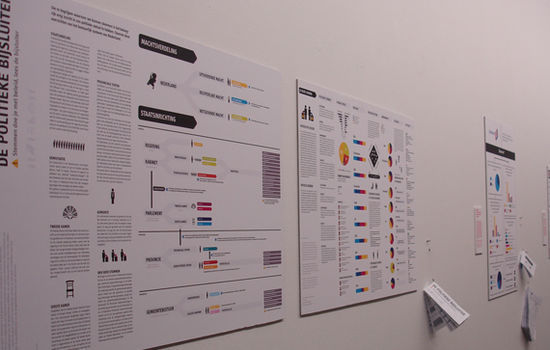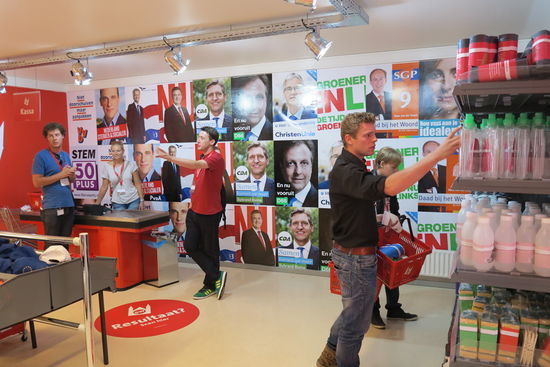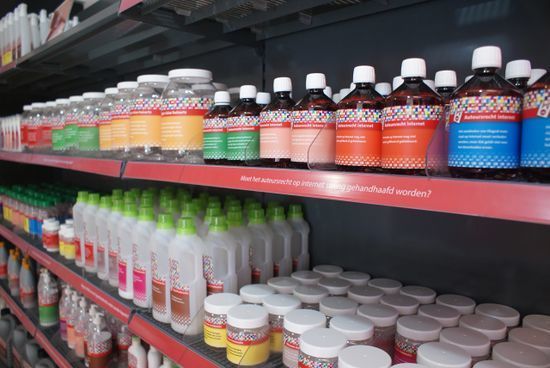Difference between revisions of "De StickerStemWijzer"
| Line 1: | Line 1: | ||
| − | = The ‘StickerStemWijzer’ (StickerVoteMatch) = | + | = The ‘StickerStemWijzer’ (StickerVoteMatch) = Renate Boere |
In 2013, Prodemos, house for democracy asked me to design an interactive tool to communicate complex information about politics. The aim was to involve more people on this topic outside the walls of the institute. Before this time ProDemos mainly distributed flyers at festivals to inform the public. We (DRS22 and Studio Renate Boere) came up with an interactive installation based on the vote match. At festivals or in the city hall you can use a sheet of stickers (agree or disagree) to show your opinion on a big installation (3 big canvasses). By doing this a discussion arises among participants that don’t even know each other. After completing all theses you insert your used sticker sheet in a scanner, the result is a personalised voting advice. In this movie you’ll see how the ‘StickerStemWijzer’ works. | In 2013, Prodemos, house for democracy asked me to design an interactive tool to communicate complex information about politics. The aim was to involve more people on this topic outside the walls of the institute. Before this time ProDemos mainly distributed flyers at festivals to inform the public. We (DRS22 and Studio Renate Boere) came up with an interactive installation based on the vote match. At festivals or in the city hall you can use a sheet of stickers (agree or disagree) to show your opinion on a big installation (3 big canvasses). By doing this a discussion arises among participants that don’t even know each other. After completing all theses you insert your used sticker sheet in a scanner, the result is a personalised voting advice. In this movie you’ll see how the ‘StickerStemWijzer’ works. | ||
Revision as of 12:48, 10 May 2016
= The ‘StickerStemWijzer’ (StickerVoteMatch) = Renate Boere
In 2013, Prodemos, house for democracy asked me to design an interactive tool to communicate complex information about politics. The aim was to involve more people on this topic outside the walls of the institute. Before this time ProDemos mainly distributed flyers at festivals to inform the public. We (DRS22 and Studio Renate Boere) came up with an interactive installation based on the vote match. At festivals or in the city hall you can use a sheet of stickers (agree or disagree) to show your opinion on a big installation (3 big canvasses). By doing this a discussion arises among participants that don’t even know each other. After completing all theses you insert your used sticker sheet in a scanner, the result is a personalised voting advice. In this movie you’ll see how the ‘StickerStemWijzer’ works.
id=8758454
The ‘StickerStemWijzer’ (StickerVoteMatch) became very popular.
Since 2014 there is also a German version of the ‘StickerStemWijzer’: the ‘Wahl-O-mat zum Aufkleben’.
Peru is interested and there are serious negotiations with Mexico an Brasilia. Something I couldn’t have dreamed of.
Contents
- 1 How did it start
- 2 Importance of having a network
- 3 Timing and distribution trough media
- 4 The ‘StemWijzerwinkel’ (VoteMatchShop) and the ‘Politieke bijsluiter’ (Political leaflet)
- 5 The ‘Politieke bijlsuiter’ (Political leaflet)
- 6 The ‘StemWijzerwinkel’ (VoteMatchShop)
- 7 The importance of working together
How did it start
Six years ago I was worried about the populistic style of communicating by some politicians. By making clever use of the ‘voice of the people’ this political leaders gained a lot of support in a short period of time.
I thought to myself; ‘can I, as designer, do something about this?’
At first an anti-campaign looked like the best solution, but at other attempts from artists like Jonas Staal the populist movement only got more media attention, and with that probably also more votes.
I came up with the following research question; Which interactive communicative tools can a designer come up with to inform the public about politics? I’m more and more convinced that the best way to really reach people is involve people by there actions, to give them authorship of there own choices. You can reach that with crossmedial interactive tools.
Importance of having a network
I asked this question, along with 4 other enthusiastic teachers, to the second and third years students graphic design at the Willem de Kooning academy, Hogeschool Rotterdam. This resulted in 120 divergent ideas to inform the public about politics in new and innovative ways.
In that same period I spoke at an opening with one of my clients from the cultural sector, the director of the CBK Dordrecht, Gerrit Willems. I told him about my irritation, and the idea that 120 students would work on this research question. He was very excited about this. He also was worried about the increasing popularity of the populistic parties and he promised me a podium at the CBK Dordrecht, just before the municipal elections in 2010. The exhibition had the name; ‘What to Do?’
Timing and distribution trough media
And so it was that the 25 best projects obtained a place in the exhibition ‘What to Do?’, just before the municipal elections of 2010.
Because of the right timing the exhibition got a lot of media attention. Radio and newspapers covered the story and the exhibition gained a lot of national publicity.
One of the employees of ProDemos heard about the exhibition and got very enthusiastic by seeing all these ideas. ProDemos (The IPP, Institute for Public and Politics at that time), mainly focused on academic research of citizen and politic. The government recently gave them the task to inform the citizens about politics. It was a coincidence that the transformation of this institute was really well timed with my motivation to inform the public about politics in another way than was happening at that time by current media.
The ‘StemWijzerwinkel’ (VoteMatchShop) and the ‘Politieke bijsluiter’ (Political leaflet)
At request by ProDemos we organized a special evening in the CBK Dordrecht to explain the 25 projects. Two projects then were chosen by the ProDemos to be realized. The ‘StemWijzerwinkel’ by Marianne Blokland and the ‘Politieke bijsluiter’ by Thijs de Jong.
The ‘Politieke bijlsuiter’ (Political leaflet)
Thijs de Jong started his research with the question: How does our political system actually functions? Soon he realised that he knew very little about the structure of the Dutch political system. What is the function of the ‘Eerste Kamer’ (senate) and what is the role of the ‘Provinciale Staten’ (Provincial Council)? He found out that it was nearly impossible at that time to find clear and structured information about these questions.
It became his mission to give a clear insight in the Dutch political system, using a minimal amount of words.
It was his ambition to make a political leaflet (like a information leaflet used in medicines) included by every ballot-paper. Unfortunately that didn’t happen yet, but Thijs, together with ProDemos, created a political leaflet used as educational material at high schools.
The ‘StemWijzerwinkel’ (VoteMatchShop)
Marianne Blokland wanted to do something on the internet but at that time she couldn’t find anything she was really interested in except the idea of online shopping. I suggested that this actually was a really good idea. The possibility to shop different theses from political parties.
The online shop never came to life, but when Marianne heard about the opportunity to exhibit her work she really wanted to make a physical store. So it happened that she designed a store where you can choose products that each display a different thesis from different political parties. As a consumer you choose the products with the thesis that fit your preference. When ‘paying’ for your products you place the barcode in front of a scanner and your political preferences are printed on a ticket.
We professionalised this shop for ProDemos. ProDemos: house for democracy has grown to a center of knowledge with 5 floors and even a replica of the ‘Tweede Kamer’ (house of commons). It is visited by 200 students a day, they learn in different ways about politics. Besides that there are exhibitions, workshops and lectures for all kind of audiences.
The importance of working together
As an artist or designer it is crucial to work together with multiple parties when you want to reach a large audience. Parties that’ll expand your decisiveness like the WDKA, parties with a public function like the CBK Dordrecht, an external specialist who know all about the latest technical possibilities like Michael van Schaik, young designers that know how to reach the young generation like the students and my trainees Silke Kuilman (DRS22) and Leonie de Ruiter (Studio Renate Boere) and last but not least parties that have the knowhow about the topic like ProDemos. But the most important party is the one that pursues the same goals as you. Without ProDemos I wouldn’t be able to reach as many people as I did.
This research led to a lot of different projects and lectures within the subject of politics and design.
Symposium 25 years StemWijzer with Jack de Vries, Kees Aarts, and Renate Boere
http://www.renateboere.nl/2014/12/15/737/
Interactive game in cityhalls for primary schools http://www.renateboere.nl/2014/04/08/democracity/
Variation on the ProDemos Stemwijzermarkt for the House of Europe http://www.renateboere.nl/2014/03/01/nieuwe-de-stemwijzermarkt-in-het-huis-van-europa/
Exhibition about the 10 worst dictators at the moment http://www.renateboere.nl/2013/08/23/%E2%80%98decadente-dictators%E2%80%99-over-weelde-en-luxe-in-dictaturen/
German variation on the StickerStemwijzer http://www.renateboere.nl/2013/08/08/wahl-o-mat-zum-aufkleben/
The StickerStemwijzer http://www.renateboere.nl/2013/04/30/de-stickerstemwijzer/
The StemWijzermarkt http://www.renateboere.nl/2012/05/21/de-stemwijzermarkt/
The StemWijzerwinkel http://www.renateboere.nl/2011/04/26/de-stemwijzerwinkel/
Interview about political posters in the Volkskrant http://www.renateboere.nl/2012/09/04/interview-volkskrant-over-het-ontwerp-van-de-verkiezingsaffiches-2012/
Political poster in cooperation with HP de Tijd: http://www.renateboere.nl/2012/08/10/campagnekunst-hp-de-tijd/



